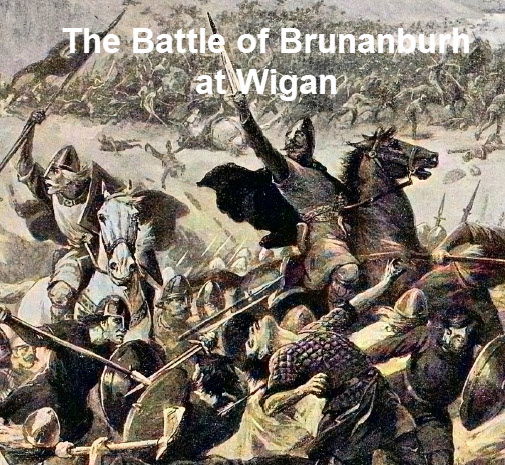The Battle of Brunanburh at Wigan?

No one is sure where the battle took place. Historians cannot even agree whether it happened east or west of the Pennines, although most agree it was in northern England. There is no shortage of candidates. Wiki reports that over 40 battlefields have been proposed, so we are not going to help matters by proposing another, Wigan. Jonathan Starkey.
Help Wanted
We believe that the Battle of Brunanburh was fought in and around Wigan. Our evidence is circumstantial and speculative, but the same applies to all the Brunanburh battlefield theories, bar one. The possible exception is the Wirral, where some medieval military archaeology has been found. If it proves to be early 10th century, perhaps we are wrong. If not, there is at least as good a case for Wigan being the battlefield location as anywhere.
Egil’s Saga, which has long been thought to describe the Battle of Brunanburh, is actually describing Guthfrith’s invasion in 927. It culminated in a battle against Æthelstan that Svanhildur Óskarsdóttir refers to as the ‘Battle of Wen Heath’. We believe it was fought at Brasside between Chester-le-Street and Durham. Once again, our evidence is circumstantial and speculative.
We are always pleased to hear from anyone interested in lost battles. If you can provide any evidence that supports (or rebuts) either of these battlefield theories, please contact us via email to momentousbritain@outlook.com.
Extract:-
Whitaker reports physical evidence of a major battle at Wigan. He says that a mass grave of horses and men was found during 1735 canal works at Poolbridge, which was near modern Wigan Pier. Hardwick elaborates in ‘Ancient Battlefields of Lancashire’: “All along the course of the channel, from the termination of the dock to the point at Poolbridge, from forty to fifty roods in length, and seven or eight yards in breadth, they found the ground everywhere containing the remains of men and horses.” He says ‘roods in length’ but a rood is a measure of area. We guess he meant ‘rods’, each being 5m. Thus, this mass grave covered an area at least 200m by 7m. A number of bodies that can only have come from a battle.
There was more fighting nearby. Whitaker says: “Closely adjoining to the site is a considerable barrow; and tradition speaks of a remarkable battle near it, in which a great officer was slain, many of the soldiers were cut to pieces, and the Douglas ran crimsoned with the blood to Wigan.” Some 400 weapons were found in this barrow near Blackrod, roughly 5km northeast of Wigan.